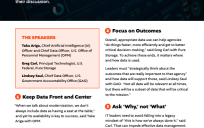As a crisis engineer, my role is not only to get you out of your current crisis, but to help you emerge with new patterns, practices, and tools that make your organization stronger and more resilient than before. Here are 5 ways you can actually emerge even stronger from your next crisis.

- Keep your eyes on the dashboard
Often in a crisis a new dashboard pops up for key metrics, such as size of a backlog, outages, or system response time. Yet once the emergency subsides, these dashboards can fall by the wayside. Find ways to keep them running and to keep extra eyes on them. I always encourage non-technical leadership to understand how to interpret and ask questions of technical dashboards. While some crises seem to come out of nowhere, most that I’ve seen have been slowly building up over time and could have been prevented if people started to sound the alarm and make changes before they boiled over.
- Continue bringing a cross-functional team together
A crisis can break down traditional hierarchies and silos, bringing people together from across the organization to add crucial context and suggest new solutions. Too often, as soon as the heat subsides, everyone returns to the status quo. While you may not need or want to maintain an incident response center 24/7, bringing the team back together at a regular cadence to review progress, brainstorm new approaches, and weigh in on cross-agency challenges should be a permanent practice.
- Prioritize ongoing solutions
Don’t lose sight of the longer-term solutions that came up during your initial triage. A band-aid or duct tape might work fine for a while, but left unattended, it will break and cause another issue later on. Set up regular check-ins to review the original causes of your issue and to ensure that longer-term or new preventative measures are underway.
- Establish a crisis communications practice
You probably created a way to communicate with employees, affected end users, and maybe even the public at large during your crisis. Preserve these communication channels so you can use them again in the future.
I have seen so many crises significantly compound because of a lack of communication. For example, in an outage, if your field employees know they can check a status page, trust that it’s accurate, and modify their work accordingly, they will not take down the organization’s help desk lines or internal chats. They’ll accommodate the outage and perhaps even enjoy a coffee break. But without such a trusted communication channel, the same critical staff members you need to fix your problem will be inundated with help desk questions and reports.
- Stay calm in the face of bad news
This is hard, but staying calm and collected in the face of the truth is the only way you’ll continue to hear the truth. And only hearing what others think you want to hear is a great way to end up in an even worse crisis later. Yelling or demanding progress totally does not work as a problem-solving method. Instead, create a safe place for honest communication, and that will surface the information needed to exit this crisis and potentially prevent a new one.
Marina Nitze, co-author of Hack Your Bureaucracy, is currently a partner at Layer Aleph, a crisis engineering firm that specializes in restoring complex software systems to service. Marina is also a fellow at New America’s New Practice Lab, where she works on improving America’s foster care system through the Resource Family Working Group and Child Welfare Playbook. Marina was the Chief Technology Officer of the U.S. Department of Veterans Affairs under President Obama, after serving as a Senior Advisor on technology in the Obama White House and as the first Entrepreneur-in-Residence at the U.S. Department of Education.





Leave a Reply
You must be logged in to post a comment.